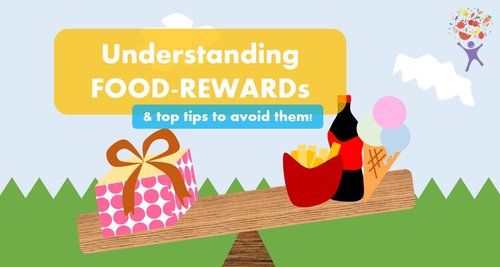Food is often used as an incentive to get children (and adults for that matter!) to do things in a certain way. “Food rewards” are common within most parenting circles and even more-so amongst those caring for people with additional needs.
Of course, food should be seen for both its nutritional value AND for it’s importance in social and cultural contexts. This means eating healthy and nutritious foods most of the time (with some consideration of nutritional value) but also enjoying foods without consideration of their nutritional “worth” during social and cultural occasions. Enjoying a slice of cake or sharing a stack of pancakes for breakfast to celebrate a birthday are both examples of appropriate eating in social and cultural contexts.
However, when food is used as a reward to motivate or encourage a particular action it can become problematic. Some reasons for this include:
– Long-term links with emotional eating.
When food is used to reward something “good” a link can become established between food and feeling “good”. In the long-term this can be linked with eating to feel better about oneself or a particular situation; or on the flip-side when feeling good reaching for food.
Tip Instead of reaching for food to switch a mood, aim to teach your child about their emotions and communicating their emotions Kids Matter has heaps of handy tips for doing this.
– It can mix up the messages you’re trying to teach
Food and healthy eating is an important part of everyday life. When one food (and let’s face it, it’s generally a less nutritious food) is used as a reward to entice eating another it automatically makes the mind think that the “other” food must have less worth. In the mind of a 3-year-old “it must be bad if I’ve got to get rewarded for eating it”.
Tip As much as possible, aim to be “neutral” about all foods. Meaning, don’t see sweets and treat as something that must be worked for or “better” than everyday foods. Instead teach your kids to enjoy these only sometimes and in small amounts.
– It can lead us to eat when we’re not hungry.
Food rewards are often given outside of the set mealtimes. Instant gratification through a food reward can see kids eating when they’re not hungry and similar to above point, set up poor nutrition foundations as they move through to adulthood.
Tip Avoid instant rewards of food. Providing instant praise and acknowledgement with a statement such as “Whow, I love the way you did XXXX” most-often brings a smile to both the giver and receiver’s face and is a good way to encourage this behaviour to be repeated.
– Concepts of healthy eating can become confusing
By giving a food as reward (and again, we’re talking about the types of high sugar/high fat foods typically given as rewards) it can confuse concepts of healthy eating that may have already been taught. In the mind of a child it’s like saying “healthy foods are the best for you but when you behave your best/ do your best you are rewarded with unhealthy food”
Tip Again, try to have a neutral approach to most foods. Aim to provide positive encouragement through words and actions rather than food items.
Many parents can relate to the tale of the child who enjoys the play-ground more than the food at a fast-food restaurant. They can relate seeing their child’s excitement in going to the restaurant and being with their friends or family and then being not fussed on the food. What fewer parents can relate to (until we challenge them to try it) is that it’s often not the food but the process that excites the child. Time spend with the family, playing together, a special occasion outside of the home irrespective of what food is on offer. It might sound crazy but we’ve worked with several families who’ve used diced vegetables (peas and carrots) when toilet training their toddler. Less conventional but proof that it can work.
Idea’s of non-food rewards are only limited by imagination. Some of our favourites include:
– Adding bubbles, colour or bath-glitter to the evening bath
– Instant praise and encouragement “I really liked the way you did XXXXX” “You make mum and dad happy when you do YYYY”
– Sticker or stamp charts. These mean children can see their progress and be proud of their efforts.
– Allowing the child to select a favourite activity or “prize” to work towards. This one works well with the sticker or stamp chart. Things like a trip to the park, a family bike-ride or watching a favourite movie all work well.
– The child becoming “Family Chef” for a meal during the week. Allowing them to select a meal for everyone to share (this works best with kids from ¬ 5 years old and if they’re given a few family-friendly options to choose from).
– Allowing extra time for art, reading or a favourite game
– Playing a favourite song or a singing a happy tune together

